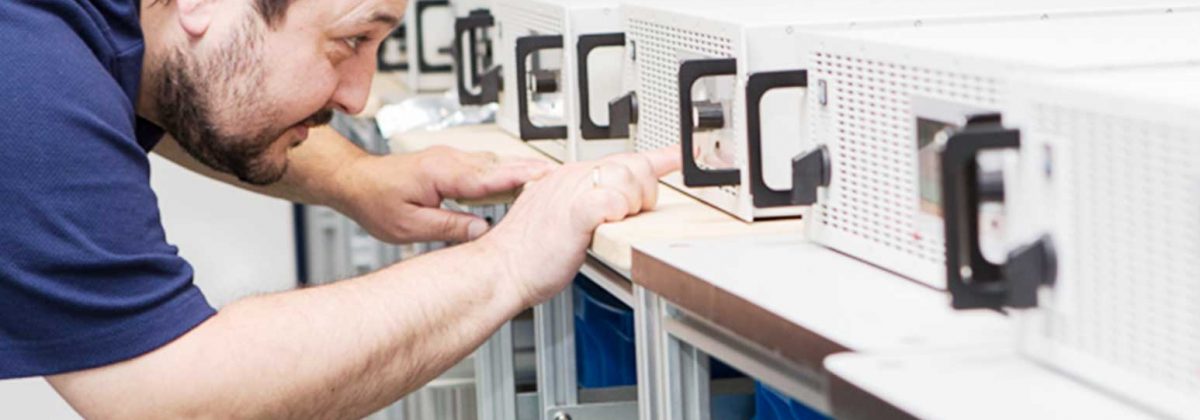Choosing a Benchtop Power Supply: What to Know
June 29, 2021 | Topics: Fuel Cell, Function Generator, Power Supplies
The problem is that different benchtop power supplies offer unique levels of functionality. With that in mind, you should look beyond your current needs and find a benchtop DC power supply that can support your intended use case in the long run.
Direct current (DC) plays an important role in the charging of batteries and the powering of many electronic systems. It’s also useful in several testing and research applications. However, the standard wall outlet emits alternating current (AC), which means you’ll need a reliable benchtop DC power supply to facilitate your research and testing needs.
This guide explains everything you need to know about these testing tools so you can make an informed decision.
Ready to Get Started? Request a Quote

What Is a Benchtop Power Supply?
A benchtop power supply is an instrument designed to support testing, prototyping, and electronic product development tasks by providing a reliable source of DC electricity. These versatile tools offer adjustable voltage and current, making them indispensable for engineers, technicians, and hobbyists working on electronic projects.
Whether it’s for designing circuits, testing components, or bringing new ideas to life, a benchtop power supply ensures that users can apply precise power settings to meet the unique demands of each application. The importance of a reliable bench power supply can’t be overstated; it allows you to administer controlled, measurable inputs to create specific electrical conditions.
Moreover, in the prototyping phase, a benchtop power supply enables you to iterate quickly, adjusting power parameters like output voltage as needed to refine your designs. This flexibility accelerates the development process, helping to bring products from concept to market faster.
Programmable power supplies offer the most versatility, as you can use them to create custom sequences or implement built-in protection mechanisms. These instruments facilitate the simulation of complex power scenarios. Several types of benchtop power supplies are available, and each one offers unique benefits.
Understanding Benchtop Power Supplies
Some of the key industries that use benchtop power supplies include:
- Electronics
- Telecommunications
- Automotive
- Aerospace
Common alternatives to benchtop units include rack-mount and modular test equipment. Rack-mount supplies are intended for integrated systems or industrial applications. They are mounted in standard equipment racks, often prioritizing higher outputs and durability for continuous operations.
Modular power supplies offer flexibility via customizable configurations, allowing you to tailor components like outputs and interfaces to your unique needs. They are best suited for complex or evolving systems.
Benchtop supplies bring the best mix of accessibility and convenience, providing your team with immediate, hands-on control for a wide range of testing and development tasks. As such, these power sources are a staple of laboratories and workshops the world over.
Key Considerations When Choosing a Benchtop Power Supply
As you explore lab power supply options, you must consider a range of factors, including the following:
Voltage and Current Requirements
First, you should think about your output power needs. Evaluate the voltage and current limit of each DC bench power supply you are considering. This will allow you to quickly rule out options that can’t provide the output current or voltage you require.
You can begin to determine your voltage and current requirements by examining your intended applications and the electronic load characteristics of the equipment you’ll be testing. Don’t choose a lab bench supply that barely meets your output needs. Instead, select an output power supply that exceeds your target thresholds by at least 25% so you can perform stress testing and other advanced evaluations.
Features and Specifications
Next, identify which features you’ll need. Some specifications to consider include:
- Regulation: The unit’s ability to maintain a constant voltage
- Ripple: The small, undesirable fluctuations in the output voltage
- Transient Response: How quickly and effectively a supply can react to changes in load
The best systems can maintain a near-constant current and voltage, even while being subjected to fluctuating input voltages. High-precision output DC voltage allows you to conduct more accurate and reliable tests and avoid overvoltage situations that may compromise your results.
Other factors to consider include set voltage and current accuracy. All systems have a margin of error. However, you must ensure that these margins fall within acceptable thresholds based on the sensitivity of your tests.
Form Factor and Size
The form factor of switching or linear DC power supplies refers to their physical specifications, including their size and shape. Consider the space constraints of your workstations and whether technicians will need to move the instruments around or store them in between testing.
If you have large workbenches, you can accommodate bigger instruments. However, ensure that they are not so cumbersome that it becomes difficult for your staff to manipulate them. Generally speaking, the more powerful the unit, the greater its form factor. However, higher-end systems tend to be more compact than their less sophisticated counterparts.
User Interface and Controls
The most basic instruments have analog controls and gauges. If you need an adjustable power supply, it will have many more controls to manipulate, which is why you need an LED or LCD display. An LED display takes the guesswork out of making adjustments to the settings, as your technicians can verify output levels in much more precise increments.
Choosing an instrument with user-friendly controls also promotes more efficient testing. With that in mind, it’s probably a good idea to get your team involved when comparing equipment options. After all, they are the ones who will be using the units every day.
Safety Features
Most high-end power supplies have advanced safety features. However, older or less sophisticated units might have fewer protections. At a minimum, you want to ensure that your benchtop DC power supply includes:
- Overvoltage protection
- Overcurrent protection
- Short-circuit protection
Purchasing equipment with robust safety features isn’t enough. Ensure you teach your technicians how to use these features so that they can keep themselves and others safe while running diagnostics tests. Safety is especially important when dealing with high-voltage or high-amperage equipment.
Types of Benchtop Power Supplies
There are multiple ways to classify benchtop power supplies. The following takes a closer look at some of the most common types to see how they compare in terms of cost-effectiveness, efficiency, and size.
Linear vs. Switching Power Supplies
Linear power supplies operate by first transforming the input AC voltage to a lower AC voltage before rectifying and filtering it to produce a clean DC output. These machines are favored for their simplicity, low noise, and minimal ripple. If you are testing audio or analog circuits or other sensitive equipment, a linear system may be a good fit.
However, linear supplies are less efficient because they dissipate excess voltage as heat, leading to larger and heavier designs due to the need for heat sinks and often fans. Despite these drawbacks, their output quality and reliability keep them in demand.
Switching power supplies use more sophisticated techniques involving converting input AC voltage to DC by rapidly switching the AC signal on and off through a transformer to achieve the desired output voltage. This process is much more efficient, allowing for smaller, lighter designs since less heat is generated. However, these systems may introduce higher levels of ripple and noise, though advancements have mitigated these effects.
Single Output vs. Multiple Output
As the name suggests, a single output supply provides one DC output voltage. They are widely used for tasks that require a consistent power source for a single device or circuit. Their simplicity and lower cost make them a practical choice for many applications.
Multiple output power supplies offer two or more independent channels, allowing users to power several devices or circuits simultaneously. A dual output supply can emit different voltages and currents from each channel. Although these instruments tend to be more expensive and sophisticated, their ability to support diverse applications makes them extremely valuable in multifaceted testing environments.
Selecting the Right Benchtop DC Power Supply
With so many options out there, it’s important to carefully compare several options before placing an order. As you begin exploring power supply equipment, consider these factors:
- Your project’s specific voltage and current requirements
- High accuracy and low ripple thresholds
- Form factor to ensure the device fits your workstation
- The type of supply (e.g., linear or switching)
Additionally, determine whether you need advanced features or functionality to accommodate more complicated requirements. For instance, if you are conducting complex tests, choosing a supply with autoranging capabilities would be wise. Conversely, if you need a simple instrument and want to minimize your initial investment costs, consider a supply that offers one output and fewer features.
Explore Our Selection of Benchtop DC Power Supply Solutions
Are you in the market for a bi-directional power supply? At EA Elektro-Automatik, we offer a wide range of sophisticated testing instruments, including autoranging DC power supplies and bi-directional systems. Our instruments feature digital displays, variable power supply functionality, and high-performance measurement capabilities to facilitate precise testing.
If you’re ready to compare top benchtop power supply options, schedule an online demo and see our offerings in action. Once you’ve found a model you like, you can request a quote from our team.

